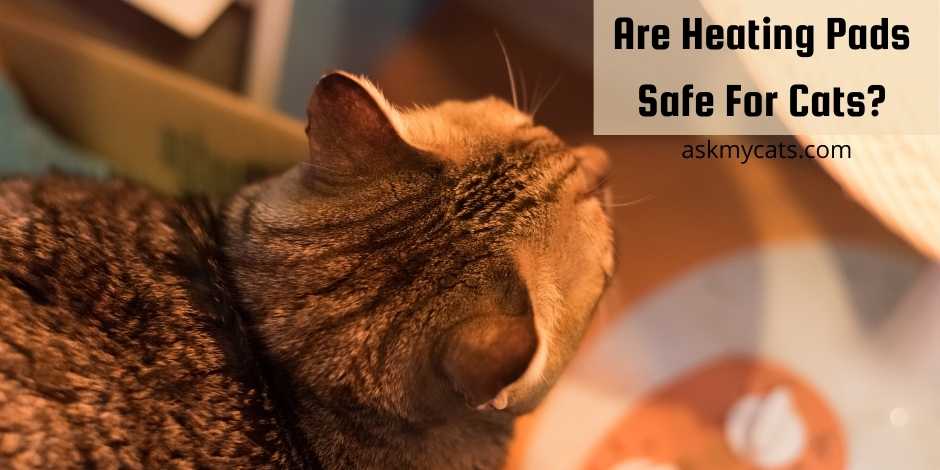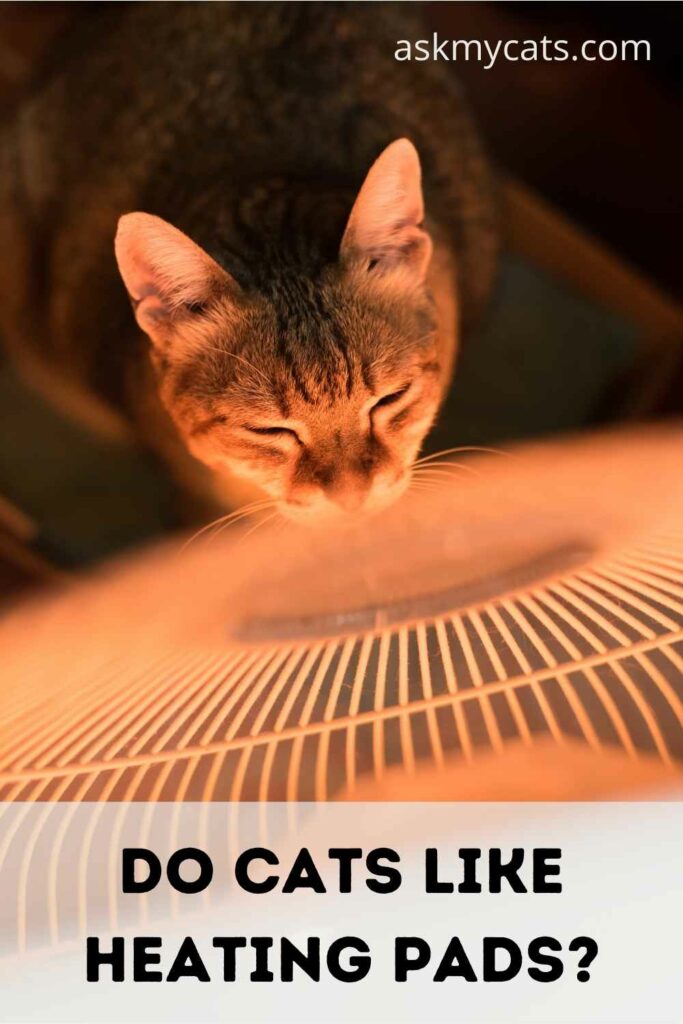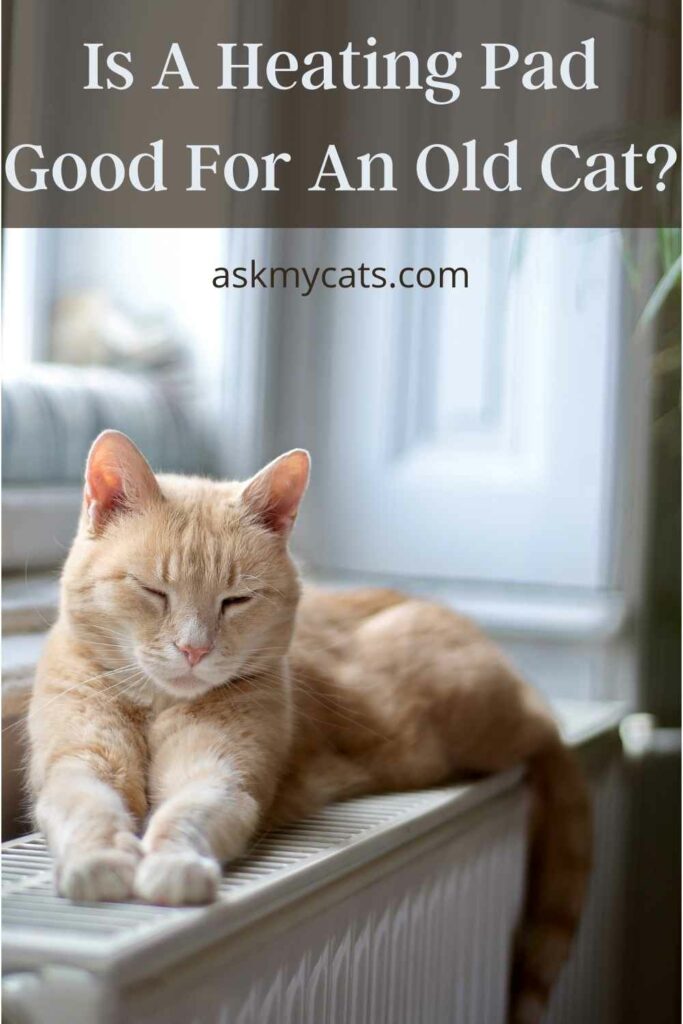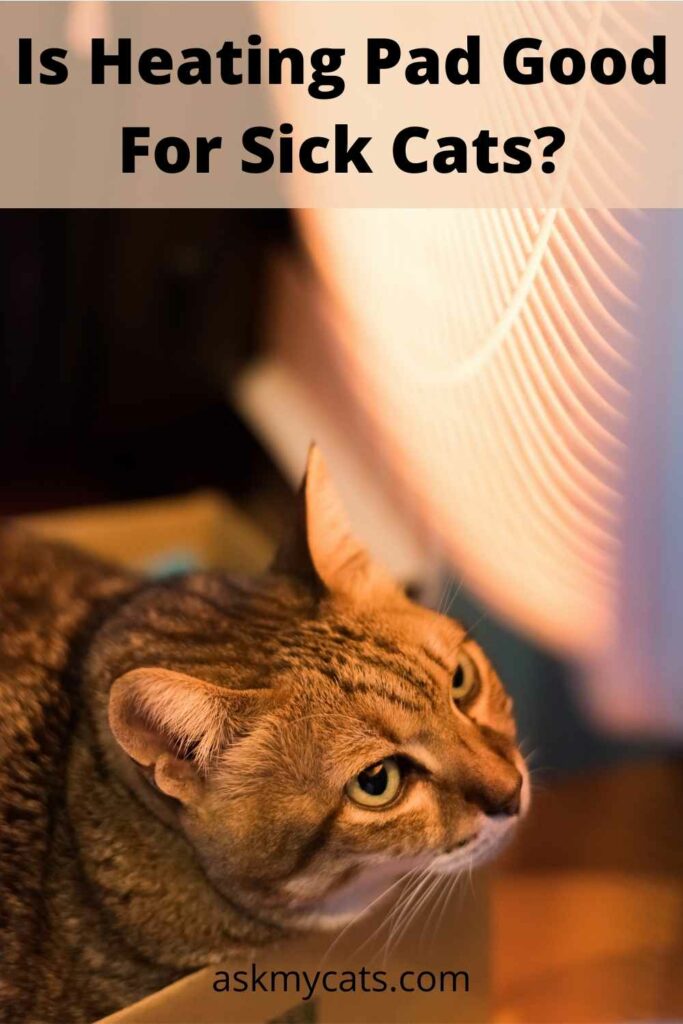Cats are physiologically driven to heat since their wild ancestors evolved in the desert. Their internal body temperature is also higher than ours, at 102 degrees Fahrenheit, implying that they must compensate for increased heat loss.
Heating pads that are set to a low or warm temperature are generally safe for cats and kittens to use. When your cat is utilising a heating pad or similar heat source, it is ideal if you supervise him.
Your cat should not lie directly on the heating pad or be exposed to high temperatures for an extended period of time. If necessary, you may cover a heated heating pad with a blanket or thick layer of cloth for your dogs.


Give Your Cat the Perfect Day
Get the Free Ebook!
Do Cats Like Heating Pads?
Cats like heating because they provide a secure environment for your cat, comparable to a lap or a warm bed.

Most cats, in fact, will think of it in the same manner and find it soothing. They can also provide a convenient resting spot for senior cats that may become stiff during the winter months.
You might be looking for a solution to keep your beloved kitty warm during the chilly winter months, especially if you have draughty windows.
Cats, like humans, are sensitive to cold, so if they spend lengthy amounts of time outside or interior temperatures are colder than normal, their immune system may be compromised, and they are more likely to become ill.
Your cat may prefer to sit near a vent or even in the sun, but with sunshine being scarce throughout the winter, what other options do you have for keeping your cat warm? A cat heating pad is one alternative. This is a tiny pad the size of a cat that rests on the floor and heats up when plugged in.
On chilly days, these pads may provide a cozy spot for your cat to sit, similar to an electric blanket.
Most cats, especially those with thick hair, require some assistance in keeping their bodies warm. This is especially true if your pet has short hair or none at all.
Cats, in general, prefer to be in warm environments. Look around your house for your pet’s favourite spots. These are most likely sunny places. A lot of it has to do with the genealogy of your pet. Wildcats that dwell in dry and desert regions developed into cats.
While heating pads provide warmth and comfort for pets, especially during the colder months of the year, you should be aware of a few possible disadvantages. Electrocution, burns, strangling, and intestinal obstruction are among them.
If you’re caring for orphaned kittens, it’s critical to give them with a source of heat other than their mother’s body heat. Set up a kitten-proof space with a low-heating pad and a soft blanket that completely covers it.
Also, make sure they have a nice blanket to rest on that isn’t directly on the heating pad (so they have the option of moving away from the heat source). With the heating pad, keep an eye on the kittens’ behaviour and check in on them regularly.
Interesting Read: How To Keep Cats Warm Without Electricity?
Is A Heating Pad Good For An Old Cat?
An electric heating pad with moist heat is a fantastic thing to put on your elderly cat’s bed since they will be attracted to the warmth, and the moist heat will assist to relieve inflammation in painful and sore joints and muscles.

Heated pads for cats are an excellent alternative for your house since they are extremely safe and consume very little electricity. These pads won’t become hotter than a cat’s body temperature, so there’s no danger of them catching fire or overheating.
A cat heating pad is a tiny, cushioned gadget that gives warmth to your pet cat as it sleeps. These pads are suitable for cats of all ages and at any time of year, although most kitties will appreciate them more when the weather becomes chilly.
In comparison to younger cats, older cats spend more time on their heating pads. There are several reasons why purchasing a heating pad for your cat might help him feel more comfortable and relieve discomfort caused by arthritis, bone and joint disorders, and other medical concerns.
Although the heat is unlikely to reach the hip joints (and so may have little effect on arthritis), some cats appear to appreciate and be soothed by a warm bed, and the warmth may improve blood circulation through tight muscles.
But be careful: I’ve seen some cats get terrible burns from being “slow cooked” on a heating pad that was too hot or poorly insulated.
A heated bed or blanket, or even a hot water bottle, might help relieve the discomfort and stiffness of arthritis in elderly cats. It may take some convincing, but if your cat gets used to the heated bed, it should provide comfort.
Older cats, in particular, may become stiff when the weather outdoors is particularly cold. When cats of all ages wake up or in the early morning, they may be stiffer. A heated pad will provide your pet with a place to relax his legs as well as other portions of his body that may get stiff.
Many veterinarians advocate keeping a heating pad on hand to allow your pet to relax during these critical times of day and seasons.
Is Heating Pad Good For Sick Cats?
Heating pads are good for sick cats because they provide the necessary warmth to the cat’s body to comfort him.

Cats are just like humans when it comes to being chilly. Your pet’s immune system may be compromised if he spends a significant amount of time outside while the weather is chilly. This means that illnesses of all kinds have a greater probability of striking him at this time of year.
As a result, your cat will be more susceptible to illness. However, if your pet gets a heated pad to lay on while he’s inside, he’ll receive enough rest and his immune system will stay healthy.
Heated beds are a favourite resting spot for many cats. A heated bed, unlike the floor or a piece of furniture, is naturally warm and gives your cat the feeling of being near to a live creature. A heated bed serves as a substitute for a human lap or a mother cat for many cats.
Heated pads for cats are an excellent alternative for your house since they are extremely safe and consume very little electricity. These pads won’t become hotter than a cat’s body temperature, so there’s no danger of them catching fire or overheating.
This also means that you may keep a cat’s heating pad on for lengthy periods of time while you are away from home without fear of the pad, your cat, or the house being damaged.
Most pet supply stores provide cat heating pads, which are typically cheap. Make sure you choose a cat-specific heating pad, since a human heating pad will have different temperature settings and may not be suitable for your pet.
Are Heating Pads Healthy For Cats?
Yes, heating pads are healthy for cats as they provide various benefits.
When the temperature becomes cold, cats, like humans, become susceptible to illnesses. Although you can’t completely prevent your cat from contracting a disease, keeping him warm increases his chances of avoiding illness.
The older your cat gets, the more difficult it becomes for him to move around. This is especially true as the season progresses.
A heating pad can assist your cat move around by decreasing stiffness, especially on cold mornings, in addition to giving warmth and comfort.
Winter may be a harsh environment for cats. Even if your cat spends all of his time indoors, he might feel cold in your house.
Are Human Heating Pads Safe For Cats?
A typical human heating pad will be far too hot for a pet’s skin, causing him or her to be fearful of the heat source.
The most serious danger of using heat treatment on a pet is skin burns. Warm, not hot, is the ideal temperature for your heating unit. Avoid putting the gadget on your pet’s skin. To avoid burning, always place padding, such as a thin towel, between the heating device and your cat’s skin.
Consider your pet’s usual behaviour, especially around electrical wires, before purchasing any of them. Although the majority of these items have stronger cords, keep in mind that they are not chew-proof.
If your cat continues to chew on the cord, it will ultimately be damaged, creating significant fire and electrocution dangers to not just your cat but possibly other family members.
Overheating is another safety hazard that cat owners should be aware of. To begin, be sure that the heating pad or bed you intend to purchase does not heat up to a temperature that is higher than your pet’s body temperature.
You should check the temperature of the heating pad from time to time. Your pet’s skin might be burnt if it gets too hot to touch.
When utilising the heating pad, you should also keep an eye on your cat’s behaviour. Your cat will display indications of discomfort or overheating, such as excessive panting, if the temperature of the bed or pad is too high.
If you’re looking for an electric heating pad or bed, choose one with a thermostat to prevent overheating.
What Is The Difference Between A Pet Heating Pad And Human Heating Pad?
The heated pet pad emits a gentle heat similar to that of a dog or cat’s normal body temperature. A typical human heating pad will be far too hot for a pet’s skin, causing him or her to become fearful of the heat source.
Cats are safe to use heating pads developed particularly for pets. This is because they’re made to heat up to the temperature of a cat’s body, not above it. This ensures that your cat is warm and comfortable without the risk of overheating.
Cats want warmth and heat, and during the winter, they are frequently considerably colder than humans are. Despite the hazards they are unintentionally courting, they will want to come as near to your additional heating as possible.
These heating pads frequently do not reduce to a low enough temperature that is suitable and safe for a toy-sized cat. If the cat lies directly on top of the pad for an extended period of time, they may burn their sensitive skin.
Are Infrared Heating Pads Safe For Cats?
Infrared heating pads can also help your cat’s muscular condition, flexibility, suppleness, and performance by targeting targets on a molecular level.
The FIR heating pad is a proven safe and efficient treatment that many patients find useful for reducing their pain from injury while at home without having to worry about the risks of burns or the side-effects of some pain medications.
Frequently Asked Questions
How hot do pet heating pads get?
This heating pad has a maximum temperature range of 100 to 104 degrees Fahrenheit, but it also includes overheat protection–if it warms up to 130 degrees, it will immediately shut off.
Is Heating bad for cats?
Although cats handle heat better than dogs (after all, they are known for seeking out sunny areas for sunbathing), cats can still suffer from overheating (hyperthermia) and heatstroke.
Should I get my cat a heating pad?
Heating pads are also a fantastic source of comfort for older cats that suffer from tight joints and arthritis. When it comes to fireplaces and space heaters, use caution. Sparks from a fireplace can be dangerous to your cat, so install a fire screen and keep your cat at a safe distance.
Final Words
During its recuperation, your cat should be kept in a warm, dry, serene, and quiet environment. There should be enough light for you to see her. It may be required to offer an extra heat source, such as a low-temperature heating pad, a heat lamp, or a hot water bottle.
What do you think about this article? Don’t forget to leave your thoughts in the comments section below!

Excellent website that is concise and to the point, giving just the right amount of specific information along with some nice, sensible do’s and don’ts and specific information is what I came here to gather. We help to save strays and orphans and have saved about 45 so far but we are old ourselves (over 80) and survive on Social Security alone so feeding getting vet treatment whenever needed and heating an out door shed for the feral cats and kittens that don’t live indoors like most of our cats (16 do at the moment) uses up most of our SS. Someone has to help these adorable, loving and innocent animals and we love doing it. Thank you for your help.
Thank you for your kind words. It sounds like you and your partner are doing a great thing by rescuing and caring for stray and orphaned cats. Providing a safe and loving home for these animals is a wonderful way to make a difference in their lives. It can be challenging to care for a large number of cats on a limited budget, but there are a few things you can do to help make things a bit easier.
First, consider reaching out to local animal shelters and rescue organizations for support. Many of these organizations have programs in place to help people who are caring for a large number of animals, and they may be able to provide you with food, supplies, and other resources. Additionally, many shelters and rescue organizations have low-cost or no-cost spay/neuter programs that can help you to control the population of cats in your care.
Another option is to look for ways to fundraise to help support your efforts. There are many different ways to raise money for animal rescue, such as hosting a bake sale, organizing a yard sale, or setting up a crowdfunding campaign. You could also reach out to local businesses and organizations to see if they would be willing to donate money or supplies to help you care for the cats in your care.
Finally, consider implementing a system for tracking your expenses and income, so that you can see where your money is going and where you might be able to make cuts or find ways to save. This can help you to make sure that you are using your resources wisely and efficiently, and can help you to identify areas where you might be able to save money.
Overall, it’s important to remember that you don’t have to do it all on your own. There are many organizations and individuals who are willing to help you and support your efforts to rescue and care for stray and orphaned cats. By reaching out for help and support, you can help to make sure that you are able to continue providing a safe and loving home for these animals.
I have an outdoor cat house for 2 Feral cats – it has an electric Heating Pad (for pets) the outside temperature where I live will plummet in 48 hours to 3 or 4 degrees F – I am trying to determine what heat level to set the heating pad to – Level 3 is 104 degrees, Level 4 is 130 degrees F – I did read that the heating pad temperature should not exceed the cat’s body temperature, does this apply if it’s only 3 – 6 degrees F outside? Thanks
Sure thing! Here’s some advice for keeping your outdoor kitties warm and toasty in their cat house when temperatures drop:
First and foremost, it’s important to make sure the heating pad temperature doesn’t get too hot for your cats. Their body temperature is around 100-102 degrees Fahrenheit, so it’s best to keep the heating pad at a temperature that is close to this range. If you set it to level 4 (130 degrees Fahrenheit), it could become too hot and potentially cause discomfort or burns. Level 3 (104 degrees Fahrenheit) is a safer bet.
In addition to the heating pad, you can also add some insulation to the cat house to help retain heat. Straw or blankets can work well for this purpose. It’s also a good idea to make sure the cat house is sheltered from wind and drafts to help keep the temperature more consistent.
Finally, it’s always a good idea to monitor the temperature inside the cat house to make sure it’s comfortable for your furry friends. If it feels too cold or too hot, you can adjust the heating pad or add more insulation as needed.
I hope this helps, and that your outdoor kitties stay warm and happy during the cold weather!
Sorry – I mean to say Level 4 gets to 113 degrees, Level 3 is 104 degrees – tonight’s low temperature will be 43 degrees F. I plan to set it to Level 2 (95 degrees)
Do you think that will be warm enough? There will be 2 cats snuggling in the Cat House!
Trying not to set it too high.
Thanks
It’s great that you’re being cautious and trying to find the right balance of warmth for your outdoor cats. Based on the updated information you provided, it sounds like setting the heating pad to level 2 (95 degrees Fahrenheit) should be sufficient to keep your cats warm and comfortable in the cat house during the cold weather.
Keep in mind that the heating pad should not be the only source of warmth in the cat house. Adding insulation such as straw or blankets can help retain heat, and making sure the cat house is sheltered from drafts and wind can also help to keep the temperature more consistent.
It’s always a good idea to monitor the temperature inside the cat house to make sure it’s comfortable for your cats. If it feels too cold, you can increase the heating pad setting slightly. Just be sure not to set it too high, as a heating pad that is too hot can cause discomfort or burns.
I hope this helps, and that your outdoor cats have a warm and cozy winter!